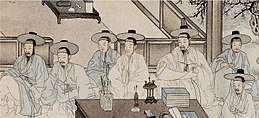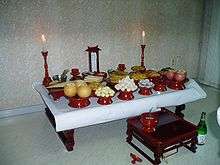Jesa
Jesa (Korean: 제사; Hanja: 祭祀; RR: jesa, Korean pronunciation: [tɕe.sa]) is a ceremony commonly practiced in Korea. Jesa functions as a memorial to the ancestors of the participants. Jesa are usually held on the anniversary of the ancestor's death. The majority of Catholics, Buddhists and nonbelievers practice ancestral rites, although Protestants do not.[1] The Catholic ban on ancestral rituals was lifted in 1939, when Pope Pius XII formally recognized ancestral rites as a civil practice (see Chinese Rites controversy).[1] Many Korean American Christians, particularly Protestants, no longer practice this rite.[2][3]
 |
| Part of a series on the |
| Culture of Korea |
|---|
| History |
|
Festivals |
|
|
Music and performing arts |
|
Media
|
|
|
Monuments
|
|
National symbols of Korea
|
| Jesa | |
 | |
| Korean name | |
|---|---|
| Hangul | 제사 |
| Hanja | |
| Revised Romanization | jesa |
| McCune–Reischauer | chesa |
Kinds of ancestor rituals
There are several kinds of ancestor rituals such as gijesa (기제사, 忌祭祀), charye (차례, 茶禮), seongmyo (성묘, 省墓), myosa (묘사, 墓祀). Gijesa is a memorial service which is held on the day of the ancestor's death every year. Gijesa is performed until upwards of five generations of ancestors in the eldest descendant's house. Memorial services that are performed on Chuseok or New Year's Day are called "charye". On April 5 and before Chuseok, Koreans visit the tombs of their ancestors and trim the grass off the tombs. Then, they offer food, fruits, and wine, and finally make bows in front of the tombs. Memorial services that are performed in front of tombs are called "seongmyo". Finally Myosa are performed at the tomb site in the lunar month of October to conduct in memory of old ancestors (five or more generations).
Ancestral rites are typically divided into 3 categories:[4]
- Charye (차례, 茶禮) – tea rites held 4 times a year on major holidays (Korean New Year, Chuseok)
- Gije (기제, 忌祭, also called gijesa) – household rites held the night before or morning of an ancestor's death anniversary (기일, 忌日).
- Sije (시제, 時祭; also called 사시제 or 四時祭) – seasonal rites held for ancestors who are 5 or more generations removed (typically performed annually on the tenth lunar month)
Performance

To perform ancestor rituals, the family at the eldest son's house prepare many kinds of food such as wine, taro soup, beef, fish, three different colored vegetables, many kinds of fruits, and rice cake or songpyon, particularly those that were favored by the deceased.[2] The shinwi (신위, 神位) or memorial tablet, which symbolizes the spiritual presence of the ancestor, is placed at the center of the table.[5] In modern days, the daughter or younger son of the family may perform these rites.
After midnight or in the evening before an ancestor's death anniversary, the descendants set the shrine, with a paper screen facing north and food laid out on a lacquer table as follows: rice, meat, and white fruits on the west, soup, fish, and red fruits on the east, with fruits on the first row, meat and fish on the second, vegetables on the third, and cooked rice and soup on the last.[6][7] The rice bowls and individual offerings to the male ancestors are placed to the west, and those of females to the east (고서비동, 考西妣東). Two candles are also laid on both ends of the table, and an incense holder is placed in the middle. In front of the shrine, they set up written prayer, if the family does not own a memorial tablet (신위).
A typical rite is generally performed following this sequence:[6]
- Kangshin (강신, 降神) – Several ritual greetings call the spirits down then follow.
- Choheon (초헌, 初獻, "initial offering") – The eldest male descendant makes the first offering of rice wine, followed by his wife. At the conclusion of the first ritual offering, the eldest son would show his respects by performing a ritual bow twice. The wife bows four times.
- Aheon (아헌, 亞獻, "secondary offering") – The second eldest male descendant (typically the next eldest sons or sons-in law) makes an offering of liquor as well.
- Jongheon (종헌, 終獻, "final offering") – The third eldest male descendant (typically the next eldest sons or sons-in law) makes an offering of liquor as well. Offerings are continued to be made until no high-ranking male descendants are left.
- Sapsi (삽시, 揷匙, "spoon insertion") – The main course is served by the eldest male descendant, to the memorial tablet, by sticking a spoon into the middle of the rice bowl.
- Yushik (유식, 侑食, "urged meal") – The ancestors receive the offerings and partake in the meal. To do so, participants leave the room, called hapmun (합문, 闔門). Afterward, in gyemun (계문, 啟門) – participants return to the room, after a few minutes. This is signaled by the eldest male descendant clearing his throat twice.
- Heonda (헌다, 献茶, "tea offering") – Tea, brewed from roasted rice is offered to the ancestors.
- Cheolsang (철상, 撤床, "removal of table") – All the attendants at the ceremony bow twice and the spirits are sent off until the next year. The table with the food and wine offerings is then cleared and the written prayer recited earlier on during the ceremony is set a fire.
- Eumbok (음복, 飮福, "drink blessings") – Participants divide the sacrificial offerings and partake in the feast. Consuming the ritual food and wine is considered to be an integral part of the ceremony, as it symbolizes the receiving of the blessings bestowed upon the family.
The altar food may be distributed to neighbors and friends in a Buddhist rite called shishik, which is a form of merit-making that, along with sutra reading and intoning of Buddha's teachings, expedities the deceased spirit's entry into Sukhavati.[2]
Modern ancestor rituals
Ancestor worship has significantly changed in recent years. These days it is common to hold ancestor rituals up to only two generations of ancestors, and in some cases, people only hold rituals for their dead parents. In addition, more people are holding rituals in the evening, not after midnight. People can also perform ancestor rituals in a younger son's house.
Today, in most Korean families, ancestor rituals still remain an important part of their culture and they are faithfully observed. These ancestor rituals, in spite of revised form, continue to play an important part in modern Korean society, which testifies to their inherent importance in the lives of Koreans.
Heotjesatbap
In Andong during the Joseon Dynasty, it was common for jesa foods to be eaten rather than used in the ceremony. Such meals were called heotjesatbap or "fake jesa food." The most common dish was a special type of bibimbap mixed with soy sauce (ganjang) instead of the more commonly used hot pepper paste gochujang. They were a common late-night snack for yangban scholars known as seonbi's, and many restaurants in Andong still serve heotjesatbap today.[8]
See also
- Death anniversary
- Jangnye
- Parentalia, similar rites in ancient Rome
- Veneration of the dead
References
- Park, Chang-Won (10 June 2010). Cultural Blending in Korean Death Rites. Continuum International Publishing Group. pp. 12–13. ISBN 978-1-4411-1749-6.
- Suh, Sharon A. (2004), Being Buddhist in a Christian World: Gender and Community in a Korean American Temple, University of Washington Press, p. 49, ISBN 0-295-98378-7
- Kwon, Okyun (2003). Buddhist and protestant Korean immigrants: religious beliefs and socioeconomic aspects of life. LFB Scholarly Publishing LLC. pp. 137–138. ISBN 978-1-931202-65-7.
- Bae, Choon Sup (August 2007). "The Challenge of Ancestor Worship in Korea" (PDF). University of Pretoria. Cite journal requires
|journal=(help) - "How to Hold Jesa". 19 September 2010. Retrieved 24 February 2012.
- Courtney, Charles; Jung Young Lee (1997). East wind: Taoist and cosmological implications of Christian theology. University Press of America. ISBN 978-0-7618-0861-9.
- The prescribed method in Hanja is as follows: 飯西羹東, 紅東白西, 魚東肉西,頭東尾西。 (반서갱동, 홍동백서, 어동육서,두동미서). Archived 2012-08-03 at Archive.today
- "Archived copy". Archived from the original on 2012-04-02. Retrieved 2011-11-09.CS1 maint: archived copy as title (link)
External links
| Wikimedia Commons has media related to Jesa. |